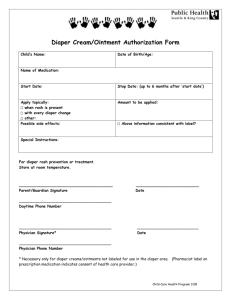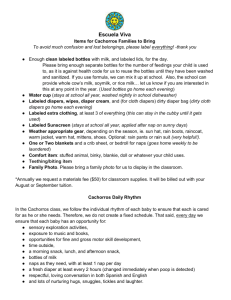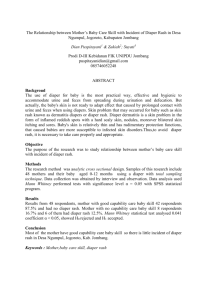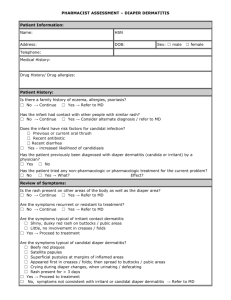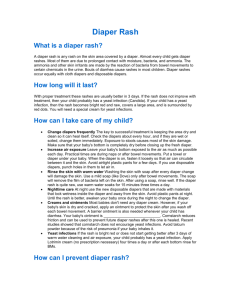What Stinks?
advertisement
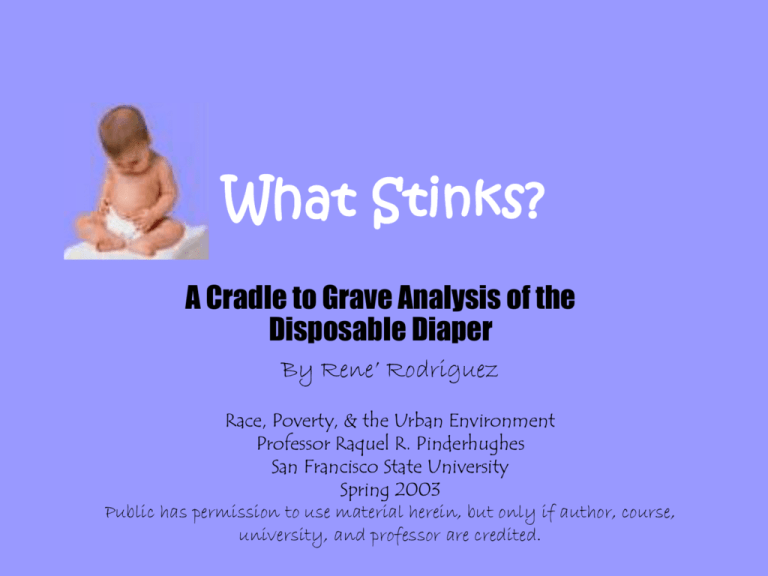
What Stinks? A Cradle to Grave Analysis of the Disposable Diaper By Rene’ Rodriguez Race, Poverty, & the Urban Environment Professor Raquel R. Pinderhughes San Francisco State University Spring 2003 Public has permission to use material herein, but only if author, course, university, and professor are credited. Introduction This presentation focuses on the disposable diaper. It takes you through the cradle to grave life cycle of the diaper, paying particular attention to the social, environmental, and public health aspects associated with the diaper. We start by looking at the history of the diaper and how it has evolved from its simple roots. We then analyze the raw materials used to make the disposable diaper, production, distribution, consumption, and its waste site, all the while focusing on the harmful impacts these processes have on the environment and surrounding communities. Diaper Evolution TIME PRODUCT ABSORBENT OUTER COVER Pre-industrial era “Primitive” diaper Grass, moss, leaves, linen or cotton Animal skins, swaddling bands (linen or wool) Late 1800s Early diaper Linen or cotton Knitted wool 1880 Safety pin 1930s-1960s Commercial laundering services 1940s Modern cloth diaper Cotton Rubber pant 1950s Modern cloth diaper Cotton Plastic pant 1961 Disposable diaper Cellulose Plastic Mid-1980s Disposable diaper Superabsorbent material Plastic Late 1990s Disposable diaper Superabsorbent material Breathable cover (www.cp.pdr.net/hostedfiles/docs/papc_diapers_site/history.htm) Natural Resources • Oil 18 billion disposable diapers used per year in US alone It takes one cup of crude oil to make the plastic in one disposable diaper • Polyethylene, Polypropylene, Polyurethane, & Polyacrylate 3.4 billion gallons of oil used annually to manufacture them 246 lbs of plastic are used to diaper a baby for one year • Wood (cellulose) It takes 200-300 kg of pulp to supply a baby for one year Over 250,000 trees are used annually for diapers (Sanders, 2001) Oil Preparing to drill • • • • • The land is cleared, leveled and roads are built If no source of water is nearby, a well is drilled A reserve pit is dug and (should be) lined A hole is dug for the oil rig More holes are dug for equipment and employee access • Sometimes rigs are built on ships (Freudenrich, 1998) Oil Drilling Anatomy (Fruedenrich,1998) Drilling the Oil • As crews are drilling, they must cement the hole to keep it from caving in. • Once they have reached a final depth, a perforating gun explosively charges holes into the casing for which oil can flow. • A well is made for oil to flow into. • Acid is pumped down the well and dissolves channels in the limestone to lead it into the well. • A fluid containing sand, walnut shells, and aluminum is used on sandstone. • Once the oil is flowing, the rig is removed and extraction begins. (Freudenrich, 1998) Extraction • After the rig is removed, a pump is put on the head of the well • The pump is forced up and down and the oil is suctioned up from the well. • A second hole is drilled and steam is injected under pressure, which helps to push it up the well. (Freudenrich, 1998) Impacts on Forest • Forests are harmed even before oil is drilled Roads are constructed into remote areas for exploration Construction destroys habitats, and roads increase traffic in fragile areas (Oxfam, 2001) Texaco constructed oil roads in Ecuador that opened 2.5 million acres of forest to colonization • Deforestation The Amason Basin has the greatest diversity of plants in So. America Eduador’s rainforests are being cut down by oil corps at a rate of 340,000 hectares a year Animals which indigenous people hunt have migrated deeper into the forests (Dabbs, 1996) • Pollution of Water Drilling produces waste muds and other gross stuff that is stored in special pits Unlined pits leak wasted into water supplies, rivers, and lakes (Oxfam, 2001) Oil placed on roads to prevent dust also flows into rivers Drinking, bathing, and fishing water sources in the Amazon have toxin levels much higher than EPA standards; fish in gulf have high mercury levels • Oil spills also poison water • Effects of water contamination Increased risks of cancer Miscarriage Demititis, fungul infections Headache and nausea Dead fish (Dabbs, 1996) www.panda.org/about-wwf/what_we_d0/freshwater/prolems.cfm Pollution of Air and Soil • Oil wells burn off natural gas polluting air and making constant noise • Gas flares produce soot which is deposited on roofs Also reduces crop growth and affects wildlife • Rain washes soot off of the rooftops Chemicals in soot can be detrimental to soil’s fertility • Oil spills contaminate top soil so that plants can’t grow (Oxfam, 2001) Middle Magdalena • Life in this region of Columbia 40% unemployed; double national rate 70% live in poverty Violence • 2 major Guerilla groups condemn foreign control of oil • 1000 pipelines blown up since 1986 • In 1998, a village was set on fire, 73 dead Pollution • Great Magdalena River polluted with sewage, industrial waste from the oil companies (Dunning, Wirpsa, 2001) Ethnocide • The people of Middle Magdalena are just one example of indigenous peoples all around the world losing their way of life to the petroleum industry • Forced emigration They must move from their rural homes into slums due to violence, pollution, and losing land • Life after leaving Children resort to prostitution to support families Little medical care No reproductive services Women in labor having complications turned away from emergency rooms • The more wealthy people in the cities mostly have no idea of the ethnocide going on around them (www.reliefweb.org, 2003) Oil Spills • Oil spills occur during accidents involving tankers, barges, and pipelines usually when the oil is being transported to us (www.response.restoration.noaa.gov, 2002) • Causes of spills Natural disasters Carelessness Illegal dumpers Equipment breaking • Pipelines are supposed to be buried to reduce risk of breaking and spilling • But they are often above ground and run though villages (Dabbs, 1996) Effects of Oil Spills • Spills can leave soil economically useless • Oil floats on water spreading out into a thin layer • Oil destroys insulation of fur and water repellent in feathers of animals • Many animals ingest oil when they try to clean themselves (NOA,2002) Oil Refining • Oil is a mixture of small and large molecules • Separating crude oil Oil is boiled; small molecules separate from large Large molecules cracked to form smaller ones The result is organic chemicals which form building blocks of plastic Other chemicals such as chlorine and lead are added to give strength, stiffness, etc. Building blocks are then heated to form long chains This polymerization turns the raw materials into plastic resin (Montague,1991) Combustion • Acid Rain Acids form from NO2 and SO2 They acidify all forms of precipitation Lead, copper, and aluminum are leached into drinking water Combustion causes excess nitrogen and phosphorus in lakes and coastal waters Seafood becomes contaminated; “dead zones” • Climate Change Burning of fossil fuels and land clearing have increased the level of green house gases (CO2) Droughts are becoming more severe Global weather patterns are changing No. latitude pipelines are threatened by permafrost melting (Epstein, Selver,2002) Workers’ Conditions • Injury and chronic disease from exposure to Cadmium Arsenic Cyanide Lead • Leukemia due to exposure to petroleum and by-products • Labor and safety rules are usually inadequate in developing or poor communities • Work related deaths in the oil extraction process is higher than all US industry worker deaths combined! (Epstein,Selver, 2001) Wood Pulpwood Plantations • Natural forests are cut down in favor of plantations 1.4 million hectares of forest in Indonesia have been cut down and replaced by plantations Plantation proponents believe that by using plantations, we won’t need to log natural forests But natural forests are used either way Indigenous communities are displaced • No comparison between forests and plantations A monocrop plantation can’t compare with the diversity (and beauty) that a natural forest has Plantations are treated with insecticides, herbicides, and fungicides Frequent harvests can leave land inviable (Brown, Flavin,2001) Tree Farm Pulp wood • Diapers contain cellulose, Kraft wood pulp • Kraft pulping Bark stripped from trees and chipped Wood chips are boiled with caustic soda Pulp becomes dark brown and very strong (Kroesa, 1990) • Bleaching Usually elemental chlorine is used Some companies such as Procter & Gamble, and Kimberly-Clark have switched to other types of chlorine which reduce discharges by 90% However, these levels are still toxic, but too low to detect (Brown,Flavin,2000) Pulp Wood Factory www.wawickint.com/html/pulp Harmful Effects of Pulping and Bleaching • Pulp and paper industry uses more water to make one ton of product than any other US industry • Also has highest intensity levels of emission • Produces stinky air and sickening water • Unidentified compounds are produced • In some Asian nations, there are thousands of mills that have no treatment systems so untreated “black pulping liquor” is released into waterways • Some aquatic life dies right away, while others suffer long term and make their way up the food chain • Bleaching also releases dioxins into the air (Brown, Flavin, 2000) • Health Effects of manufacturing Plastic and Paper Legionaire’s Diease Type of pnemonia Can be deadly Caused by using injection molding equipment (www.osha.gov,1984) • Irritating materials and fumes Runny nose and eyes Sore throat, cough, asthma (www.hse.gov.uk/pubs/indg195.htm) • Polyacrylate Female organ problems, slow wound healing, and weight loss to employees (Sanders, 2001) • Water Bad taste Employees in Buckeye Mill (later) told to add powdered mix for flavor (Swasy,1993) • Smell Pulp and Paper Mill Odors • Kraft Pulping Process produces gaseous sulfur compounds Sulfides, ammonia, other organic compounds Smell=rotten eggs EPA says odors are annoying but not a health concern Odors vary depending on processing techniques, wind direction, temperature • Health Issues When weather causes chemicals to become concentrated • Eye and breathing irritations • Headache and nausea • People with asthma may have asthma attacks (EPA says these are not health concerns…???) (www.dhfs.state.wi.us/eh/HlthHaz/fs/PulpOdors.htm,2000) • Dioxins • What are they? Dioxins Dioxin is a general term for hundreds of chemicals formed by burning chlorine based compounds with hydrocarbons (www.ejnet.org/dioxin, 2002) • What do they do? They get into the air, then soil and water, and then our food chain They attach and accumulate in our fat cells Dioxin is passed onto our children • Through placenta, and breastfeeding We have no defense because it is not metabolized in our bodies It can cause serious health problems at parts per trillion (www.acereport.org,2003) (www.ejnet.org/dioxin,2002) Harmful Effects of Dioxin • • • • Causes cancer Disrupts hormones May shrink penis size and sperm count Miscarriage, reproductive disorders, birth defects, low birth weight • Learning disabilities • Short term memory and attention span • Damage to nervous and immune systems (www.acereport.org,2003) The Buckeye Mill • A Procter & Gamble pulp mill in Perry, FL near the Fenholloway River • Effects on River P&G purchased land in 1954, drained areas of river to plant trees Began discharging 50 million gallons of discharge per day In 1990, dioxin levels were 1900x the acceptable risk Remains worst river in country Wells and backyards contaminated Shower water leaves film on skin Female fish have developed male characteristics because the pollution causes hormone changes (Swasy, 1993) The People of Perry • P&G shapes all aspects of life there • Segregation still exists; locals refer to African-Americans as “niggers” • Those who grew up drinking the water and eating food nourished by water now suffer from Arthritis, short term memory loss, lung problems • Free bottled water is now provided by P&G • They depend on the P&G facility P&G provides many jobs; many would go bankrupt without it Company gets preferential treatment from local politicians and law enforcement People won’t challenge the company • In 1990s, a few women who began exposing and challenging their practices were harassed; one even beaten and raped (Swasy, 1993) Production of the Diaper Manufacturing Process • A sheet of pulp is converted into fibers • The fibers are mixed with a super absorbent • A pad is formed, compressed and cut into individual pieces • Poly material is added at the bottom and nonwoven at the top • Hot melt is used to glue it all together • Elastomers are added for stretch in the waist and leg cuffs • Tapes are added and can be adhesive or mechanical (Velcro) • Individual diaper pieces are cut, inspected and stacked for sealing and boxing (www.giga.com/~cricher/carlos.html) Diaper Making Machine (www.giga.com/~cricher/carlos.html) The Finished Product (Krafchik,2000) Components of The Diaper • Polyethylene: the outside,breathable, leakproof • Polypropylene: against baby’s skin, keeps skin dry • Polyurethane: elastic on cuffs • Polyacrylate: Super Absorbent Polymers, absorb 30x their weight • Cellulose: draws liquid into the center • Glue: holds diaper together, made of resin and oil (Krafchik, 2000) Kimberly-Clark • Tests on Animals • Low score, 57, on Human Rights Campaign 2002 Rates policies on gay and transsexual employers, consumers, and investors • One of the companies responsible for hazardous waste at Chemsol federal superfund site in New Jersey (www.responsibleshopper.org) Picture: (www.thenewparentguide.com/shopping-disposable-diapers.htm) Proctor & Gamble • Tests on Animals • Paid scientists to testify at FDA hearing on the fat substitute “Olestra” • Supports pollution secrecy legislation Would provide immunity from environmental crimes if they are self reported • One of the companies that sued Massachusetts for preventing companies from doing business in Burma (www.responsibleshopper.org) Picture: (www.pg.com.hr/press/pictures/index.html) Advertising • Commercials Show features such as stretchy waistbands, more comfort, cartoon characters • Coupons Sent by mail, in magazines • Free samples By mail In Hospitals • Given to 4 million newborns a year (Swasy, 1993) Diesel Exhaust • Most diapers are distributed to our retail stores by diesel trucks Walmart is connected to P&G by computer so diapers are replenished almost instantaneously (Swasy,1993) • What is diesel? Diesel fuel is burned in the engine and soot and gases are released into the air Soot consists of tiny particles that are inhaled into our lungs Particles have cancer causing chemicals called Polynuclear Aromatic Hydrocarbons Gases in diesel exhaust • Nitrous oxide, formaldehyde, sulfer dioxide, carbon dioxide, carbon monoxide, benzene (www.asfscme.com) Harmful Effects of Diesel • Accounts for 71% of cancer risk from toxic air contaminants • The particles inhaled stay in your lungs for a long time which can lead to corroding cells and tumor growth • The average infant in SF reaches the EPA’s acceptable lifetime limit for exposure to carcinogens by 19 days of life • People who live closer to areas of high truck traffic get higher doses (www.greenaction.org) Health Effects of Diesel on Workers • Those most likely to be exposed to diesel exhaust Bridge, tunnel, loading dock workers Auto mechanics Truck drivers • Short term effects Irritation of eyes, nose, throat Lightheadedness, feeling high Heartburn Headache,vomiting Chest tightness, wheezing • Long term effects Has been linked to lung cancer Workers more likely to have chronic respiratory problems, reduced lung capacity, bronchitis (www.afscme.org) Harmful Effects of Wearing Diapers • Diaper Rash Caused by allergies to chemicals, temperatures from wearing plastic, and less diaper changes because diaper is so absorbent it feels dry Natural moisture along with urine is absorbed • Infertility in Males Testicles may become hot from wearing diapers and may not develop normally (Sanders, 2001) • Toxic Shock Syndrome In 1986, a 13 month old Missouri boy and NY girl both died allegedly from wearing Pamper’s diapers (Swasy, 1993) Picture:(www.askdrsears.com) Toxic Shock Syndrome • TSS became famous in the early 80s when at least 42 women died from wearing P&G’s Rely tampon (pulled from market) • Symptoms The tampons created a haven for bacteria which produced deadly toxins High fever, sunburn like rash, vomiting Victim’s skin peels off hands and feet Lungs fill with fluid until suffocation, heart stops beating • Pamper’s Ultra Diaper introduced in 1986 Immediately there were complaints of rashes, and beads (Super absorbent polymers turn into beads when wet) Testing showed that carboxylmethyl cellulose that was used in the Rely tampons was in the diapers P&G reformulated but there were still cases up to 1993 and 2 deaths SAPs currently in diapers were also in the Rely tampons (Swasy,1993) The Grave Landfills • How much? Diaper is the third largest consumer item in landfills It equals 30% nonbiodradable waste in landfills 2% total municipal solid waste Each baby contributes 1 ton of garbage (Sanders, 2001) Decomposition • Some are up to 85% biodegradable • However, most are rolled into tight little balls and put in sealed landfills • Without air and water, it take about 500 years for the diaper to decompose • Can we compost them? Plastic is non compostable US has only 20 facilities that could do this composting Many more would have to be built…NIMBY (Sanders, 2001) www.redamedia.com/bubbles/diaper.htm Health Hazards • Human waste The American Public Health Association advise that fecal matter should not be put in with the regular trash because it contaminates ground water and spreads disease • Parents should rinse out fecal matter in the toilet before throwing diaper away (doesn’t happen) Five million tons of untreated human waste in landfills • There are approximately 100 intestinal viruses living on the feces • They could be carried by insects right back to us (Sanders,2001) Exposure • Impacts on Neighborhoods Water contamination due to dumping or leaking liners Disposal sites and waste treatment facilities can cause air pollution and landfills are a breeding ground for insects and rodents who spread disease Preschool children and workers are most impacted • Direct dumping of untreated waste in water bodies can make its way up the food chain • Exposure to certain untreated chemicals can cause disease and/or death (www.edugreen.teri.res.in/explore/solwaste/health.htm) Occupational hazards associated with waste handling • Infections Skin and blood infections resulting from direct contact with waste, and from infected wounds. Eye and respiratory infections resulting from exposure to infected dust, especially during landfill operations. Different diseases that results from the bites of animals feeding on the waste. Intestinal infections that are transmitted by flies feeding on the waste. • Chronic Diseases Incineration operators are at risk of chronic respiratory diseases, including cancers resulting from exposure to dust and hazardous compounds. • Accidents Bone and muscle disorders resulting from the handling of heavy containers. Infecting wounds resulting from contact with sharp objects. Poisoning and chemical burns resulting from contact with small amounts of hazardous chemical waste mixed with general waste. Burns and other injuries resulting from occupational accidents at waste disposal sites or from methane gas explosion at landfill sites. Source - Adapted from UNEP report, 1996(www.edugreen.teri.res.in/explore/solwaste.health.htm) The Bottom Line The disposable diaper doesn’t just originate at the store and then end up in the garbage. By examining the cradle to grave cycle, we see that the disposable diaper is harmful at every stage in its life with disproportionate impacts to those not able to do anything about it. By using the main components of the diaper, oil and wood, we cause irrevocable damage and the anthropomorphic and environmental costs are priceless. Most people who use these disposable diapers are impacted in the smallest ways, with a minor diaper rash being the only clue that diapers are not healthy. The other impacts were mostly invisible to us-until now. The most important point about the grave of the diaper is simply that it has one. Something that is completely non-reusable is a waste of it’s entire life cycle. All that harm for what? A product that is used for a few hours and then unsafely thrown out as a ball of plastic and feces to sit for 500 years. References • • • • • • • • Brown, Lester R., Flavin, Christopher. State of the World 2000. WW Norton and Company Dabbs, Corbett J., Oil Production and Environmental Damage, December 1996, <www.american.edu/projects/mandala/TED/projects/tedcross/xoilpr15.htm> April 15,2003 Dunning, Thad. Wirpsa, Leslie. Oil Rigged. February 2001: Resource Center of the Americas. February 20, 2003 <www.americas.org/News/Features/2001 02_Colombia_Oil/20010201_Oil_rigged_in_columbia.asp> Epstein, R. Paul; Selber, Jesse, Oil: A Life Cycle Analysis of its Health and Environmental Impacts, The Center for Health and the Global Environment, 2002 <www.med.harvard.edu/chge/oil.html> May 6, 2003 Fruedenrich, Craig C. Phd, How Oil Drilling Works, How Stuff Works, 1998, <www.howstuffworks.com/oil-drilling2.htm> May 6, 2003 Krafchik, Bernice, Disposable Diapers: Layer by Layer, 2000, <www.cp.pdr.net/hostedfiles/docs/papc_diapers_site/layer.htm> February 12, 2003 Kroesa, Renate. Greenpeace Guide to Paper. Vancouver, BC: Greenpeace International, 1990 Oxfam, Environmental and Health Effects of Mining and Oil Extraction, May 24, 2001<www.oxfamerica.org/advocacy/art407.html> April 15, 2003 • Sanders, Heather L., The Diaper Drama: An Online Drama of Disposable versus Cloth Diapers. 2001. Punkin-Butt. February 10, 2003 <www.punkinbutt.com> • Swasy, Alecia, Soap Opera:The Inside Story of Procter & Gamble. New York:Random House Inc, 1993 • <www.acereport.org/emissions.html> Dioxin Exposure, ACE 2003 • <www.afscme.org/health/faq-dies.htm>, Diesel Exhaust, American Federation of Employees, April 15, 2003 • <www.dhfs.state.wi.us/eh/HlthHaz/fs/PulpOdors.htm> Human Health Hazards-Pulp and Paper IndustryOdors, 2000 (May 22, 2003) • <www.edugreen.teri.res.in/explore/solwaste.health.htm>, Health Impacts of Solid Waste, May 1, 2003 • <www.egnet.org/dioxin> Dioxin Homepage. Action Center 2002 (May 10, 2003) • <www.greenaction.org/stopdiesel/factsheet.shtml> Action Alert: Diesel Fact Sheet. Green Action. February 21, 2003 • <www.hse.gov.uk/pubns/indg195.htm> Health and Safety Executive, 1998 • <www.giga.com/~cricher/carlos.html> Manufacturing Process of a Disposable Diaper. May 18, 2003 • <www.osha.gov> Osha Hazard Information Bulletion, 1998 (May 16, 2003) • <www.reliefweb.com> May 15, 2002, UN High Commission for Refugees. May 15, 2002 • <www.response.restoration.noaa.gov/kids/spills.html> What’s the Story on Oil Spills?, Office of Response and Restoration, 2002, April 15, 2001
